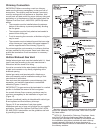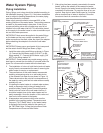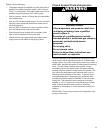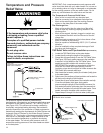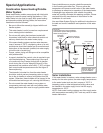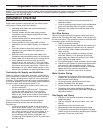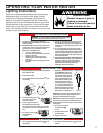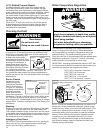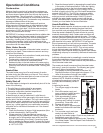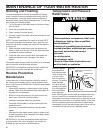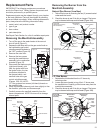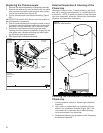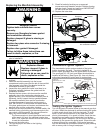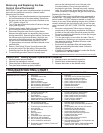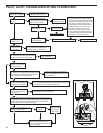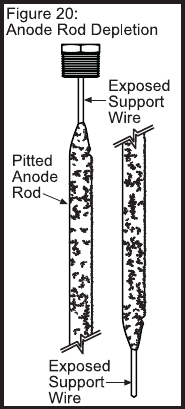
19
Operational Conditions
Condensation
Moisture from the products of combustion condenses on
the tank surface and the outside jacket of the water heater
and forms drops of water which may fall onto the burner or
other hot surfaces. This will produce a “sizzling” or “frying”
noise. NOTE: This condensation is normal and should not be
confused with a leaking tank. Condensation may increase or
decrease at different times of the year.
High efficient energy saver water heaters will produce
larger amounts of condensation on initial start-up or when
a large amount of hot water is being used. NOTE: Do not
confuse this with a “tank leak”. Once the water reaches a
temperature of 120°F and the tank warms up (usually 1-2
hours), the condensation will stop.
IMPORTANT: It is always recommended that a suitable drain
pan be installed under the water heater to protect the area
from water damage resulting from normal condensation
production, a leaking tank or piping connections. Refer to
Location Requirements. Under no circumstances is the
manufacturer to be held responsible for any water damage in
connection with this water heater.
Water Heater Sounds
During the normal operation of the water heater, sounds or
noises may be heard. These noises are common and may
result from the following:
1. Normal expansion and contraction of metal parts during
periods of heat-up and cool-down.
2. Condensation causes sizzling and popping within the
burner area and should be considered normal.
3. Sediment buildup in the tank bottom will create varying
amounts of noise and may cause premature tank failure.
Drain and flush the tank as directed under “Draining and
Flushing”.
Smoke/Odor
The water heater may give off a small amount of smoke
and odor during the initial start-up of the unit. This is due to
the burning off of oil from metal parts of a new unit and will
disappear after a few minutes of operation.
Safety Shut-off
This water heater is designed to automatically shut-off in the
event of the following:
1. The pilot flame is extinguished for any reason.
2. The water temperature exceeds 180°F (83°C).
3. Excessive combustion chamber temperatures.
4. The ignition of flammable vapors.
A thermocouple is used to determine if a pilot flame is
present, and will shut off the gas supply to the main burner
and the pilot if the flame is absent. This unit is also equipped
with a thermal switch, designed to shut off the gas supply in
the event the water heater has been exposed to flammable
vapors (e.g., spilled gasoline), poor combustion caused by
a blocked vent or insufficient combustion air. If the thermal
switch opens:
1. Check the flame-trap for signs of high temperature (blue
or black discoloration). See Figure 28A.
2. If there are signs of high temperature, inspect your
installation for any problems with venting, combustion
air supply and for a flammable vapor event (see Pilot
Light Troubleshooting Flow Chart). Correct any issues
prior to resetting the thermal switch. Contact the Product
Service and Support Department for service information
at 1-877-817-6750.
3. Reset the thermal switch by depressing the small button
in the center of the thermal switch. Follow the Lighting
Instructions found on the front of your water heater.
A high temperature limit switch or ECO (Energy Cut Off) in
the tank is used to shut off the unit if the water temperature
exceeds 180°F (83°C). The ECO is a single-use switch,
which, if activated, requires complete replacement of the
entire gas control valve/thermostat. If the ECO should
activate, the water heater cannot be used until the gas
control valve/thermostat is replaced by a qualified person.
Contact your local dealer for service information.
Anode Rod/Water Odor
Each water heater contains at least one anode rod, which
will slowly deplete while protecting the glass-lined tank
from corrosion and prolonging the life of the water heater.
Once the anode is depleted, the tank will start to corrode,
eventually developing a leak. Certain water conditions will
cause a reaction between this rod and the water. The most
common complaint associated with the anode rod is a “rotten
egg smell” produced from the presence of hydrogen sulfide
gas dissolved in the water. IMPORTANT: Do not remove
this rod permanently as it will void any warranties. The parts
list includes a special anode that can be ordered if water
odor or discoloration occurs. NOTE: This rod may reduce
but not eliminate water odor problems. The water supply
system may require special filtration equipment from a water
conditioning company to successfully eliminate all water odor
problems.
Artificially softened water is exceedingly corrosive because
the process substitutes sodium ions for magnesium and
calcium ions. The use of a water softener may decrease the
life of the water heater tank.
The anode rod should be removed from the water heater
tank every 3 years for inspection. The following are typical
(but not all) signs of a depleted anode rod:
• The majority of the rods diameter is less than 3/8”.
• Signifi cant sections of the support wire (approx. 1/3 or
more of the anode rod’s length) are visible.
If the anode rod show signs of either or both it should be
replaced. NOTE: Whether re-installing
or replacing the anode rod, check for
any leaks and immediately correct if
found.
In replacing the anode:
1. Turn off gas supply to the water
heater.
2. Shut off the water supply and
open a nearby hot water faucet to
depressurize the water tank.
3. Drain approximately 5 gallons
of water from tank (Refer to
“Draining and Flushing” for proper
procedures). Close drain valve.
4. Remove old anode rod.
5. Use Teflon
®
tape or approved pipe
sealant on threads and install new
anode rod.
6. Turn on water supply and open
nearby hot water faucet to
purge air from water system. Check for any leaks and
immediately correct any if found.
7. Restart the water heater as directed under “Operating
Your Water Heater.” See the Repair Parts Illustration for
anode rod location.
TEFLON is a registered trademark of E.I. Du Pont De Nemours and Company.



